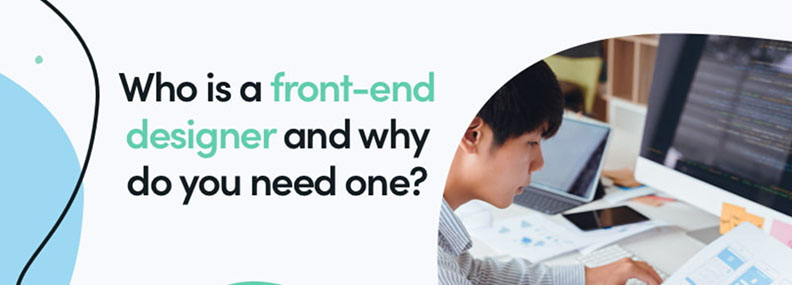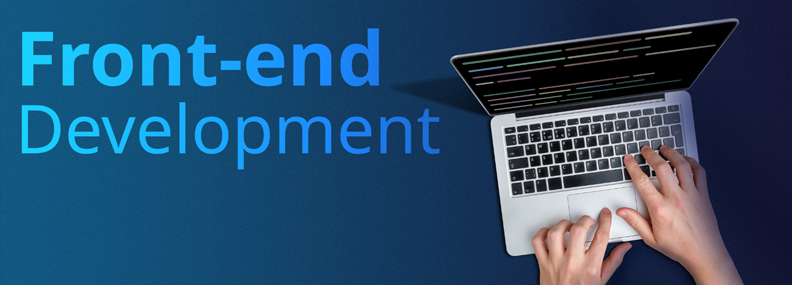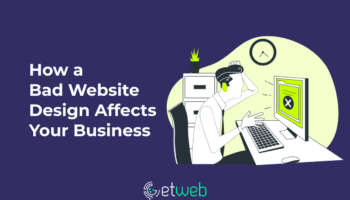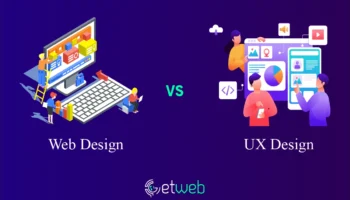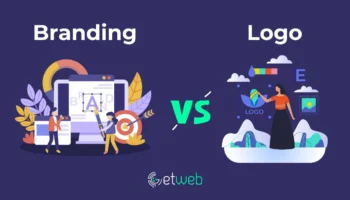Front-end designers are on the rise as more and more brands are trying to create a strong online presence. However, there are a number of confusions around this profession.
Many people still don’t have a clear idea about what they actually do and how they can help businesses thrive.
Our today’s guide will focus on explaining who a frontend designer actually is, what are their responsibilities, and what tools they use.
We’ll also discuss the skills a front-end designer should have and what impact they can have, in case you want to recruit them for your company.
Who is a Front End Designer?
To be blunt, everything you see on a website as a visitor is considered “Front-end.” Any website or application has two main parts: server-side AKA “back-end”, and client-side AKA “front-end”.
The back end deals with the heavy stuff. All the business logic, databases, and code are stored in the back end whereas the front end deals with the visual elements of a website.
In a nutshell, a front-end designer is a computer science professional who decorates the webpage with visuals and interactive elements to make the platform aesthetically pleasing and easy to navigate.
Roles and Responsibilities
The key responsibility of a front-end designer is to understand the vision and design concept of the client, and then implement those concepts through buttons, logos, images, search bars, fonts, whitespaces, and other design elements. They are responsible for how a webpage looks and feels across various screen sizes.
Frontend designers are also responsible for the navigation system of a website. The goal here is to make it easy for the visitor to find the information they are looking for. They create navigation links that take the visitors exactly where they want to go, improving the overall user experience.
Front End vs Back End: What’s The Difference?
Both front-end designers and back-end developers are computer science professionals that work with the different parts of a website.
Frontend designers are responsible for how a website looks whereas backend developers focus on things like information architecture, database management, and website security.
For a website to attract visitors smoothly, it needs support from both fronts. One can’t function properly without the other. Only when front-end developers work with back-end developers in sync, a website reaches its full potential.
Aside from which side they work on, there are a couple of things that separate these two professionals.
Front-end designers use HTML, CSS, and JS to create and place visual elements whereas back-end developers use technologies like PHP, Java, MySQL, and jQuery to structurize the website and control the data flow.
Due to the higher complexity of back-end development, it is also offered as a standalone service (BaaS — Back-end as a service). The same can’t be said for front-end development.
In a nutshell, front-end design and backend development requires different skill sets and technologies, works in different environments, and solves different problems; all toward achieving a common goal: to reach your website’s full potential.
Expertise a Front-End Designer Should Have
As technology progresses, more and more expertise is being added to the expected skill list for a front-end web designer.
However, there are some core skills that you need to check before you hire a frontend designer for your company.
Here are the key competencies a front-end designer should have:
Technical Skills
Key Technologies
HTML
HTML is a markup language that is used to create and structurize websites. This is the core technology behind every website available online.
HTML stands for Hyper Text Markup Language and is considered the most basic building block of front-end design and development.
CSS
CSS is another crucial technology used to design and decorate HTML web pages. The name stands for Cascading Style Sheets.
Front-end designers use CSS to style webpages with color, fonts, transitions, layouts, and other visual elements.
If HTML is the boney structure of a skeleton, CSS would be the muscle, skin, hair, and other organs that improve the visual part of that structure.
JS
JavaScript (JS) is a programming language primarily used to add different functionalities to a webpage. Most of these functionalities are interactive, meaning the user can trigger the action.
Whether you want to add simple functionalities or complex applications, JavaScript is the go-to language.
Libraries, Frameworks, and Preprocessors
Coding everything from scratch every time seems like a lot of hassle. That’s why many web designers reuse parts of their codes instead of building every element from the ground up.
That’s the idea behind libraries and frameworks. They make the design process less tedious and more efficient.
Nowadays, there is an abundance of libraries and frameworks that can add a range of functionalities to your web pages.
Preprocessors are dedicated scripting languages that use a special compiler to create CSS files. These are used to extend the limitations of CSS code in a browser.
Some of the most widely used libraries and frameworks are Bootstrap, React, jQuery, Angular JS, and NodeJs.
A front-end designer should have a solid understanding of the core technologies, libraries, frameworks, and preprocessors needed to create stunning web pages.
Version Control
Version control systems are used to keep track of the changes done to the website files. In case the developer makes some kind of mistake, they can track down the previous working version instead of starting everything from scratch.
Nowadays, Git is the most popular application to track the website’s development and lets multiple designers and developers collaborate easily. A versatile front-end designer should have basic knowledge of repositories like Git and GitHub.
Content Management System
Content management systems (CMS) are designed to help users to craft, edit, publish, and store digital content. The most widely used CMS is WordPress, which runs almost half of the total websites online today.
Other popular CMS include Joomla, Magento, and Drupal. What type of CMS your website runs on or you are planning to migrate to will decide which specialty you want in a front-end designer. However, in most cases, basic knowledge of WordPress will be enough.
Responsive Design
Nowadays, more and more people are visiting websites through their phones. That’s why the need for responsive design is on the rise.
Here the term “responsive” means the webpage will change its layout, content, and functionalities (sometimes) depending on the user’s screen size.
You can either keep the base version of your website on a mobile device or develop mobile-specific designs. Most responsive designs feature a simplified version of the base design.
The designer you’re about to hire should have sufficient knowledge of responsive designs.
Testing and Debugging
Bugs (coding errors) are inevitable. No matter how apt your designer is, bugs will happen. That’s why it’s crucial for a front-end developer to be familiar with various testing and debugging processes.
UI testing and unit testing are two of the most commonly used testing methods to find bugs. Once the developer locates the bug, the next step would be to take the bugs out, find out why they’re failing, and fix the problem.
If you want to provide a positive user experience, you should recruit a front-end designer familiar with the testing and debugging process. Although this part mainly falls upon the shoulders of a developer, a front-end designer should also have a basic idea.
Browser Development Tools
People use a wide variety of browsers to access webpages depending on their preferences. Each browser works in a slightly different way and uses a different webpage rendering process.
What works smoothly on a specific browser might not work at all in others.
With browser development tools, front-end designers can identify the issue. Every browser is equipped with a browser development tool that usually contains an inspector and a Javascript console.
This tool allows designers to edit the HTML and CSS code and see the changes in real-time. A professional front-end designer should be familiar with multiple browser development tools.
Soft Skills
Creativity
A front-end designer needs to bring your ideas to life with a functional, and intuitive website.
Creativity is a key skill here. A creative front-end designer will craft visual elements that complement your idea and influence your users to take action.
Problem Solving
Bug fixing requires nothing but one’s problem-solving skill. There are also a couple of places where problem-solving skills will be needed.
If you are planning to design a hyper-functional website, focus on the problem-solving abilities your front-end designer has.
Adaptability
A front-end designer needs to adapt to different situations in order to provide a fruitful result.
The work environment, working process, tools, and design decisions may change at any moment. The designer will have to adapt to new challenges if and when they arrive.
Communication
Communication is crucial in collaborating effectively and maintaining a steady workflow. This is a must-have interpersonal skill for almost any profession.
Without maintaining fluid and transparent communication, your design project is bound to fail.
Be careful about the communication efforts a designer puts into their work before hiring.
Collaboration
Effective collaboration is another crucial skill any professional should have, let alone a front-end designer. A designer will have to maintain fluid communication with other teams and stakeholders in order to go forward in the project development cycle.
Effective communication and collaboration will help you achieve your goals faster.
Tools a Front End Designer Use
Front-end designers need to use a variety of tools to create stunning websites. The tools a versatile designer will use include but aren’t limited to:
- Core technologies
- Frameworks/libraries
- CSS preprocessors
- RESTful Services/APIs
- Content management systems
- Version control systems
- Code editors
- Testing/debugging tools
- Cross-browser/browser-specific platforms
Front End Designer Hiring Cost
If you’re looking to hire a full-time front-end designer, you’ll have to spend around $70,000 per year (Glassdoor).
For a mid-level designer, the salary will become $85,000 per year, and you’ll need to pay up to $115,000 per year for a senior level front-end-designer.
You can also hire freelance designers to complete your project. On average, a mid-level freelance front-end designer will charge $40-55 for an hour.
How a Front End Designer Can Impact Your Business
Leave a Lasting First Impression
The first impression plays an important role in the case of web solutions. Even you yourself will be frustrated if a website you’re visiting takes more than 3 seconds to load, or has terrible visual elements, right?
A website or an application only has a couple of seconds to create a positive first impression, and a seasoned front-end designer can help you with that.
Leveraging industry best practices and years of practical knowledge, an experienced designer will assure the best first impression you can have on your visitors.
Makes Navigation Easier
When front-end designers create a web solution, they focus on both usability and visuals. It won’t help you if you have a splendid design but it’s hard for the visitor to move around pages.
The main purpose of your web solution is to provide the information easily to the users the most hassle-free way possible.
Once your visitors realize that the navigation system is great and they’ve found exactly what they were looking for easily, you’ll bookmark your website for future uses.
That’ll help to build trust among your users and increase your solution’s credibility.
Beneficial for User Retention
If your designer develops interfaces that are intuitive and user-friendly, fewer people will be willing to start using another web solution for the same task you’re doing.
This will help you keep the existing users satisfied and bring those visitors back who only visited your website once.
The better and more convenient completing a task would be on your web solution, the more and more visitors you’ll be able to maintain. Aside from boosting your performance metrics, this also helps gain many new customers.
Boost Performance
There are many businesses that provide good service, but don’t have a strong online presence. A thoughtfully designed website can change all that.
An attractive and fast-loading page will keep the visitor engaged for a long time, boosting the chance of turning that visitor into a customer.
However, front-end development is also crucial here. If the website/application is slow, that can seriously damage your performance.
Slow websites and applications frustrate visitors like nothing else. It’s one of the leading causes of losing web traffic.
Align Branding Efforts
The visual of a website shouldn’t feel confusing to any visitor, or they’ll seek alternatives. The website should reflect the purpose of a business.
Front-end designers are responsible to communicate across numerous teams of stakeholders and decision-makers.
As a result, front-end designers can maintain a consistent image of your company’s branding efforts. Front-end designers help everybody to align their efforts and create a welcoming user experience.
Boost Brand Awareness
Front-end designers can also help your business create a strong and universal brand image across multiple channels. The more people you’ll be able to attract, the more your brand will grow.
No matter the size, shape, or form of your business, a skilled designer can help you reach more people and improve your brand awareness.
To create an immersive website/ web application and guide your users to a positive user experience, you’ll need professional help from a skilled front-end designer. They’ll also have a significant impact on the brand image you’re trying to establish.
Word of Mouth
Once you develop strong brand awareness, people will start talking about your business. This can create good word of mouth for your company.
This also helps to build trust with your users, reach a wider customer base, and keep your existing users’ content.
However, creating positive word of mouth takes a lot of consistent effort and positive reinforcements. A well-designed website can become one of those reinforcements, significantly impacting your overall business performance.
FAQs
1. Is Python Front End or Back End?
Python is one of the most popular coding languages of today. With a flexible programming structure, Python can be used in both front-and back-end programming. That’s why it’s considered a full-stack language.
2. Is Front End Development Dying?
No. Even if there are a lot of AI-powered, drag-and-drop website builders, manual front-end development isn’t going to die out anytime soon.
There will always be demand for quality and complex design, which is hard to replicate on today’s AI engines.
3. Is Front End Design and Development the same thing?
Not really. Front-end designers are responsible for creating and placing all the elements of a website in a manner that is visually pleasing and user-friendly.
On the other hand, front-end developers are responsible for transforming those visual elements into functional codes.

 Let's Talk
Close
Let's Talk
Close

